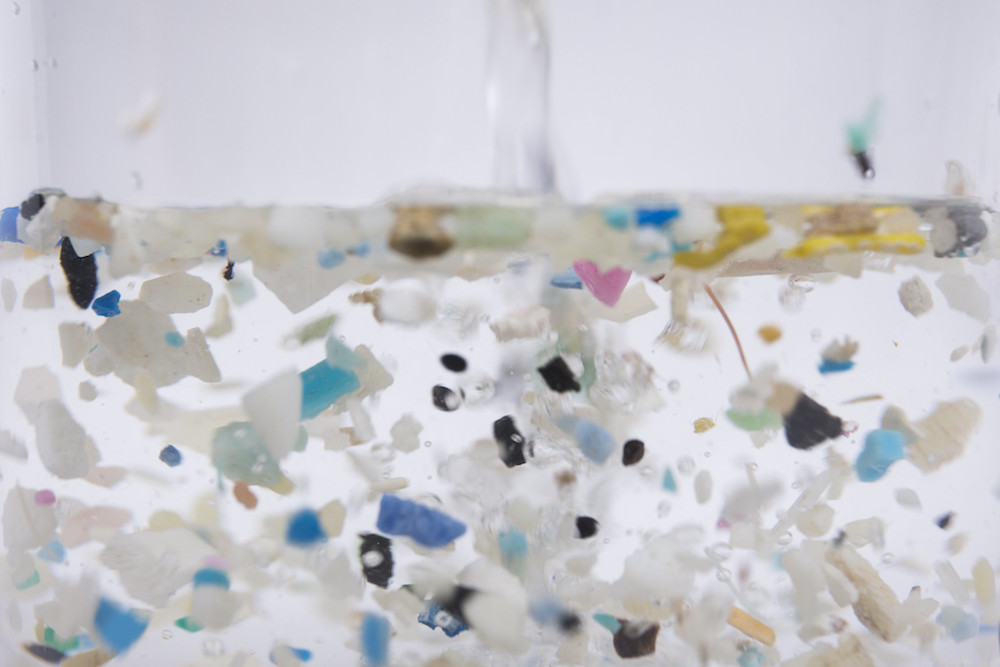
[Image above] You may not be able to see them, but microplastic pollution is more ubiquitous than large plastics in marine ecosystems. How can we rid the oceans of this harmful trash? Credit: Florida Sea Grant, Flickr (CC-BY-NC-ND 2.0)
A turtle caught in a fishing net. A seahorse hugging a cotton swab. An albatross with its stomach filled with plastic.
These images and more proliferate our news feeds daily, demonstrating the ubiquity of and destruction wrought by plastic pollution in our oceans. They motivate us to conduct beach cleanups and build giant nets that collect floating plastic for easy disposal.
There is, however, a hole in these good-faith efforts—the majority of plastic particles in the ocean are microplastics.
Microplastics are small pieces of plastic debris less than 5 mm (0.2 inch) in length. Primary microplastics are purposefully made that size (for example, microbeads in body wash) while secondary microplastics are products of large plastics degrading over time.
A graph published by Our World in Data illustrates how microplastics dominate macroplastics in particle count across the world’s surface ocean waters. And new research in Scientific Reports reveals that just as much, if not more, microplastics accumulate in deep ocean environments (depths of 200–600 m) as on the surface.

Many primary microplastics end up in the ocean because wastewater treatment facilities do not filter particles that small. And once in the ocean, those small particles are not collected by many ocean cleanup methods.
Collecting large plastics is important (in part because it prevents large plastic from degrading into microplastics), but ridding the ocean of microplastics also is key. Organisms that mistakenly consume microplastics as food can die when their stomachs are unable to digest the material, and microplastics can both adsorb and give off chemicals and harmful pollutants. (The full extent of microplastic harm to the environment is an active area of research.)
Methods that focus on trapping or collecting trash, which work well for large plastics, will not effectively rid the ocean of microplastics. However, methods that break microplastics down into compounds that do not pose a threat to marine ecosystems are a promising approach.
A research collaboration between University of Adelaide, Curtin University, Edith Cowan University, and Guangdong University of Technology in China are investigating such a method. Their technique involves using tiny coil-shaped carbon-based magnets to break down microplastics.
“Carbon nanosprings are strong and stable enough to break these microplastics down into compounds that do not pose such a threat to the marine ecosystem,” senior author Shaobin Wang, professor of chemical engineering at the University of Adelaide, says in a university press release.
Carbon nanosprings break down the microplastics through a mechanism called advanced oxidation processes (AOPs), a chemical remediation technology involving short-lived chemicals called reactive oxygen species (ROS). ROS trigger chain reactions that chop the various long microplastic molecules into tiny segments that dissolve in water.
The researchers explain in the paper that recently AOPs “have exhibited great capability for complete mineralization of persistent organic pollutants in water.” However, the heavy metals used to produce ROS create secondary pollution from metal leaching and massive sludge generation, which hinders the practical application of this technique.
Carbon nanosprings offer a solution. “Alternatively, metal-free nanocarbon materials such as graphene and carbon nanotubes (CNTs) have emerged as promising alternatives to metal catalysts in AOPs, owing to their engineered dimensional structure, tunable physicochemical properties, and environmentally benign nature,” the researchers write.
They note that a challenge with nanocarbon materials is the trade-off between catalytic performance and stability in an oxidative environment. But the researchers resolved this conflict with heteroatom doping (e.g., boron, nitrogen, sulfur, and phosphorous) into the honeycomb structure of bonded carbon atoms (sp2 carbons) to create more active sites with enhanced catalytic activity.
The researchers created nanocomposites consisting of manganese carbide nanoparticles encapsulated in helically nitrogen-doped carbon nanotubes. In just eight hours, the nanocomposites removed a significant fraction of microplastics in water and remained stable in the harsh oxidative conditions needed for microplastics breakdown.
In addition to presenting a green alternative to metal catalysts, the carbon nanosprings included a small amount of manganese, making them magnetic. (The manganese was buried far from the surface of the nanotubes to prevent leaching.)
“Having magnetic nanotubes is particularly exciting because this makes it easy to collect them from real wastewater streams for repeated use in environmental remediation,” project coleader Xiaoguang Duan, research fellow at University of Adelaide, says in the press release.
Because microplastics vary widely in chemical composition, the researchers next plan to ensure the nanosprings work on microplastics of different compositions, shapes, and origins. They also plan to continue confirming the nontoxicity of any chemical compounds that occur as intermediates or as by-products during microplastics decomposition.
The paper, published in Matter, is “Degradation of cosmetic microplastics via functionalized carbon nanosprings” (DOI: 10.1016/j.matt.2019.06.004).
